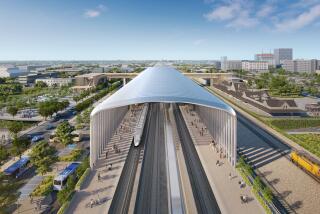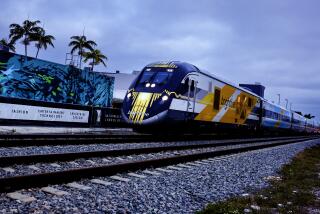Hope of China’s Interior Rides on New Track
FUYANG, China — During the day, the new glass-and-chrome Bank of China building here is a 25-story symbol of respectability befitting this city’s designation as an emerging railway center.
But at night, the uniformed bank guards and the bustling business people retreat. Sidewalk karaoke bars, China’s forlorn open-air honky-tonks, crank up the off-key ballads. Aggressive prostitutes ply the pavement. And the bank’s marble apron converts into a flophouse for the impoverished flotsam of one of China’s most chronically neglected regions.
“I’ve been sleeping here for two days, since my land was flooded,” said Liu Lianxing, 64, a peasant who walked three days to Fuyang from his village so that he could make money as a beggar. “I’m old. Nobody wants me. What other kind of work can I do?”
When the economic boom thundered into China, sprouting skyscrapers and creating a class of “instant noodle capitalists” in Shanghai, Beijing and along the country’s southern coast, the alluvial plains of central China remained locked in the wrenching poverty that novelist Pearl Buck wrote about in her 1931 classic “The Good Earth”--which was set here in Anhui province.
As China’s coastal boom continues, the economically retarded interior belt formed by Henan, Anhui, Hubei and Jiangxi provinces--home to more than 240 million Chinese--has become both an embarrassment to the central government and, in the minds of some analysts, a potential source of civil unrest.
*
In an effort to integrate the neglected interior with the coastal boom zone, China’s government today plans to inaugurate a new 1,575-mile, $4.8-billion railroad line that will pass through Fuyang and cut a swath through hundreds of other backwater territories on its way from Beijing to the British colony of Hong Kong.
The new railroad, built in three years and completed four months ahead of schedule, connects Beijing, the Chinese capital, with Shenzhen, the manufacturing center in southern Guangdong province, just across the border from Hong Kong. When Hong Kong reverts to control by mainland China next July, the new line will connect directly with the colony’s Hung Hom Station in the harbor-side area of Kowloon.
Except for the $30-billion Three Gorges Dam project on the Yangtze River, the Beijing-Kowloon railroad is the country’s most ambitious infrastructure project.
Constructed largely without heavy machinery by more than 210,000 workers, it has won grudging praise even in archrival Taiwan, where an editorial writer recently complained that the Communist mainland was able to build a major rail line connecting the country’s north and south in less time than it has taken capitalist Taiwan to build a mass transit system for its capital, Taipei.
Most of China’s natural resources--its coal, metal ores and oil--are located in the country’s interior; the rail line will provide a cheap and efficient mode of transportation. But in international terms, China has always been rail-poor. In 1896--27 years after the United States completed its first transcontinental railroad--China had only 370 miles of track. Even today, the U.S. railroad system amounts to nearly a yard of track for every person; the equivalent in China is less than two inches. Until the new line was built, the country had only half the per-capita rail mileage of India, which benefited from the rail expertise of British colonialists.
“Many Chinese,” Yale University historian Jonathan D. Spence wrote, “considered railways disruptive to the harmony of nature and of man: They sliced across the land, disturbing its normal rhythms and displacing its benevolent forces; they put road and canal builders out of jobs and altered established market patterns.”
To reach the coasts, China historically depended on its great east-west waterways, the Yangtze and Yellow rivers. For 1,300 years, the main north-south transportation route was the Grand Canal, built between the sixth and ninth centuries under the Sui and Tang dynasties.
China’s only other north-south rail line, which runs parallel to the new line and is 100 miles to the west, was completed after many fits and starts in 1920 and is seriously overburdened.
The new line, the most extensive rail project ever attempted in China, represents a victory for central planning officials seeking a more efficient, environmentally sound alternative to the road-building frenzy favored by provincial leaders.
“Highways and railways both have their advantages,” said Ministry of Railways official Zhang Jianji, the man in charge of the new route. “Highways are fast and run door to door. But railways have the advantages of low cost, the ability to carry large quantities of goods and are also friendlier to the environment. The cost of building a highway is three times that [of] a railway.”
*
Here in Fuyang, local officials see the railroad as a way out of the poverty that has racked their region for centuries. During the 1960 famine that followed a series of natural and political disasters, such as Communist Party Chairman Mao Tse-tung’s chaotic Great Leap Forward program of industrialization, thousands of peasants in the Fuyang area starved to death.
“Because of natural disasters and leftist policies, the living conditions here were terrible,” said Mayor Li Hezhong, 52, who first came to Fuyang as a village political organizer during the 1966-76 Cultural Revolution. Like other political activists of his generation, Li said, he joined in the rallies condemning Communist Party leaders Deng Xiaoping and Liu Shaoqi when they were portrayed as counterrevolutionary villains by Mao and his inner circle.
“I shouted ‘Down with Deng Xiaoping’ along with everyone else,” said Li, tugging nervously on his conservative silk tie.
But after Mao died in 1976 and Deng came to power, Li became a convert to the economic reforms whose benefits he now hopes the rail line will help foster in Fuyang.
“This railroad is a big chance for us,” he said during an interview at a local hotel. “Never in history has so much attention been paid to Fuyang.”
Despite its rich farmland and a plentiful supply of coal and other natural resources, Fuyang’s per-capita annual income of $700 lags the national average of $900. Here are signs of poverty that are found in few other places in China: shirtless peasants pedaling passengers in bicycle rickshaws and barefoot construction workers armed with shovels.
Some locals blame the central government for the area’s backwardness.
“They’ve treated us for years like China’s Siberia” is a common refrain--although Fuyang’s wet, verdant terrain, with its waving fields of rice, corn and sorghum, bears little resemblance to Russia’s frigid north.
With the new rail line--including a major freight-marshaling yard that will employ 10,000 workers--and other planned infrastructure projects such as new roads, a new power plant and a new airport, Li said he is hoping to reverse Fuyang’s fortunes.
By the year 2010, the mayor said, Fuyang should surpass the national per-capita income. “Today we are already the fastest-growing area in Anhui province,” he said.
Many residents, buoyed by railroad fever, share Li’s enthusiasm for Fuyang’s brighter future. The business cards of local officials and business people display maps of the new rail line and the four other smaller lines that converge here.
“The railway will make the city famous,” said newsstand owner Tian Helong, 42.
“We can use the railway to carry our agricultural products. And I can enjoy more of the fresh fruits from the south,” Tian said.
*
Fuyang fought hard for its place on the Beijing-Kowloon line. The city competed with Shangqiu, a city in adjacent Henan province, for the freight yard, which is one of the rail system’s largest and most modern, capable of handling 10,000 freight cars a day.
In many ways, it was a contest evocative of the 19th century competition between cities in the American West for a spot on the Union Pacific. In its rush to build the line, the Ministry of Railways needed 10,000 mu--the equivalent of 1,650 acres of cleared land. Shangqiu offered the land at the equivalent of $1,200 a mu. Fuyang underbid its rival by half.
“We have a saying in China: ‘If you want to be prosperous, build a highway. If you want to get rich quickly, build a railway,’ ” said Zhang, the ministry official in charge of the project. “Fuyang offered us the land already cleared.”
“We had 2,000 people moved off the land within 20 days,” Li said proudly.
Fuyang got the freight yard.
Now that it has its railroad and freight yard, Fuyang is hoping to overcome its reputation as the source of cheap migrant labor for the rest of the country. When people in the big cities of China are asked about Fuyang, they generally identify it as the place that supplies good household maids and coal handlers, jobs that other Chinese reject.
Located in the northwest corner of Anhui province, Fuyang is one of the country’s main sources of migrant labor. According to Li, more than 1 million of its 13 million natives work outside their home territory, toiling on construction projects in Shanghai and on assembly lines in the special economic zone on the fringes of Hong Kong.
After China eliminated its strict national work-permit system a decade ago, many young Fuyang residents took to the road seeking their fortunes, joining the tide of more than 100 million internal migrants in the country.
In Shanghai, the number of Fuyang migrant workers is estimated at 200,000. During the annual Spring Festival, China’s New Year, the Shanghai railway department arranges for special trains to carry 9,000 Fuyang workers a day back home for the holidays.
One of the main goals of the central government in attempting to develop China’s interior is to help stem the tide of migrant workers, which the government views as destabilizing.
But while Mayor Li has high hopes that the new railroad line and freight yard will bring prosperity to Fuyang, he is less optimistic about reversing the migratory flow.
“Fuyang is the second most densely populated locale in China after Chongqing,” he said, referring to the Yangtze River port in Sichuan province that is also known as one of China’s main labor exporters. “Naturally, we have a lot of surplus labor.”
(BEGIN TEXT OF INFOBOX / INFOGRAPHIC)
New Chinese Rail Line
Beijing -- Kowloon Fact Sheet
Construction started: 1993
Total Investment: $4.8 billion
Total length: 575 miles
Workers involved: More than 210,000
One-way ticket: $23.40
More to Read
Sign up for Essential California
The most important California stories and recommendations in your inbox every morning.
You may occasionally receive promotional content from the Los Angeles Times.










